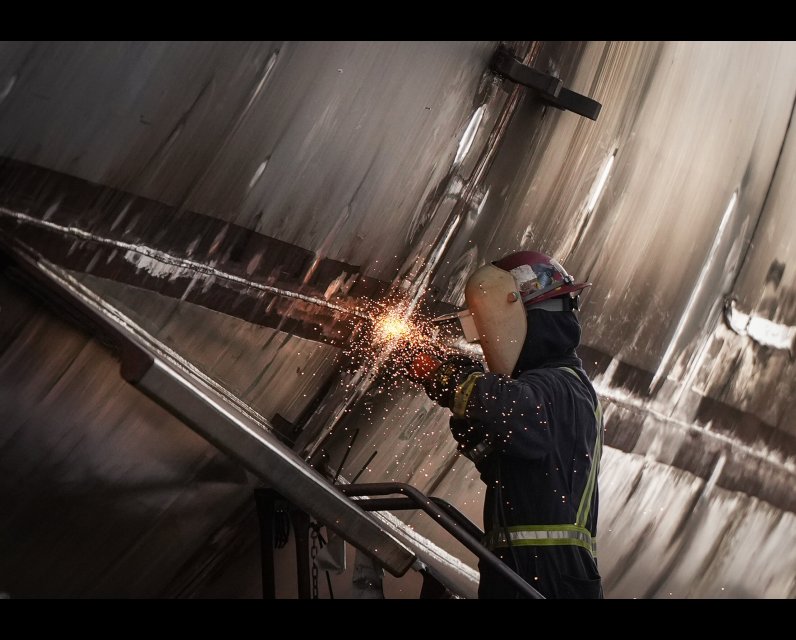There Was a Time Canada Really Did Build, Baby, Build

W hen I walked into the cabinet room in the Centre Block of Parliament for my first cabinet meeting in 2015, I remember feeling a mixed sense of excitement and trepidation. This moment was the culmination of several years of hard work for me as the member of Parliament for Durham, but it was also the result of several decades of dreaming for someone who wanted to serve the country in higher office. The moment also left me thinking about the gravity of the situation, as I hoped to contribute to the critical debates and decisions facing the country in a meaningful way.
I was early for the meeting and was savouring this special moment when a painting on the wall of the cabinet room caught my eye. It was from the Canadian War Museum collection that adorned many of the official spaces in Ottawa. What drew me in was the centrepiece of the painting. It featured ships being built in an old dry dock, with the shipyard workers involved in the construction featured in the foreground. I had never seen the painting before, and it appeared to be something from the Great War given that a horse was being used to haul materials. As I leaned in to read the nameplate beside the painting—Shipbuilding in Ashbridges Bay, Toronto, 1918—I was blown away by where this shipyard was located.
Shipbuilding in Ashbridges Bay, Toronto, 1918—Robert Ford Gagen, Canadian War Museum collectionCanada built ships in the Beaches? This was the question I asked myself as I stared at the canvas. I knew Ashbridge’s Bay very well, because I had run the trails in that area for the years that Rebecca and I had lived in the Beaches neighbourhood. The Beaches (or “The Beach” to purists) is a stretch of the Lake Ontario shoreline beginning with the iconic R. C. Harris water treatment plant in the east and ending with Ashbridge’s Bay in the west. It is comprised of beaches, parks, and quaint shops along Queen Street a block up from the beachfront. It is generally an area of outdoor recreation, with the exception of the waste treatment and water filtration plants that bookend the neighbourhood. I knew there had been an amusement park located there a century ago, but I had never heard about any industry in the area. The thought of the Beaches being a major centre of wartime industry was almost hard to believe.
With my curiosity piqued, I later tracked down some information about what happened in Ashbridge’s Bay during the First World War. The history I found revealed what our country can really achieve when we seize the moment. It is a history we would do well to replicate today.
N ot only did ships get built in Ashbridge’s Bay during the Great War but I learned it was also home to the largest electrical steel plant in the world. A plant that was purpose built for the war effort and was closed and dismantled only a few years after the war ended. The steel plant was built on reclaimed land in Ashbridge’s Bay that served almost as a pop-up economy to drive the Great War supply effort.
In many ways, the Great War was the first “Canadian moment.” Not yet fifty years old as a country, Canada wanted to seize the opportunity to step up as a former British colony and play a serious role in the war effort both on the front lines and in the critical supply mission. This first Canadian moment led to Ashbridge’s Bay being transformed from a swampy marsh along the eastern Toronto waterfront into what could be described as the most important multipurpose industrial site in Canada during the Great War. What was even more remarkable was the fact that Ashbridge’s Bay went from fallow to factory in less than a year. Build, baby, build, indeed.
This remarkable transformation was made possible by the Imperial Munitions Board. The IMB was created in 1915 to lead the industrialization of the Canadian economy for the purposes of the war effort. It was born out of the Shell Crisis of 1915 that paralyzed the British parliament and caused a crisis of confidence for the government due to the lack of shells and munitions for a nation at war. The British government turned to Canada to help with the dilemma through the creation of a new agency to be led by business leaders and military officers to drive the munitions supply initiative at breakneck speed to help win the war.
Prime minister Robert Borden accepted the British request and dispensed with the ineffective and scandal-ridden Canadian Shell Committee that had been the fiefdom of the controversial militia minister, Sam Hughes. The Hughes board was dismissed and the new IMB board created through an Order-in-Council, with reporting authority directly to the British War Office. Toronto industrialist Joseph Flavelle was selected as the chairman of the IMB and was given remarkable power to drive investment and production. Within weeks, Flavelle had organized the IMB into twenty different departments and had production plans underway for everything from shells and explosives to timber, steel, and shipbuilding. By the end of the war, the IMB had constructed several national factories through its own subsidiaries and had contracted with over 650 different production facilities across Canada to help the Allies win the war.
The British Forgings steel plant in Ashbridge’s Bay is a case study of the success of the IMB. It all went from a proposal in late 1916 to the construction of the largest electrified steel plant in the world that was pouring steel by the summer of 1917. The IMB empowered the project with a $3 million grant and provision of the land for the plant courtesy of the Toronto Harbour Commission.
The IMB also oversaw the construction of ships for merchant shipping, as the British merchant fleet had been disrupted by the war, with shipyards focused on supporting the Royal Navy. In 1917, the IMB was asked to help address the shortage of ships for the merchant marine, and it began placing orders for ships made of both steel and wood given the shortages in steel the war was causing. The newly formed Toronto Shipbuilding Company leased land in Ashbridge’s Bay to build ships and received an IMB commission for two 3,200-tonne wooden steamship vessels. It was these two vessels—the War Ontario and the War Toronto—that are featured in the painting by Robert Ford Gagen.
By the time the Armistice was signed on November 11, 1918, ending the war, the British Forgings steel plant had produced 48,000 tons of steel and more than 3 million shells for the Allied war effort. Nineteen ships had been built over the course of the war by Toronto-area shipbuilders, including the War Ontario and War Toronto built in Ashbridge’s Bay. These ships were two of forty-six wooden vessels commissioned by the IMB alongside twenty-six steel vessels for the war effort. The shipbuilding industry in Toronto was so significant to the war effort that the Canadian War Memorials Fund commissioned Gagen to memorialize this wartime industrialization. He produced seven works spanning several shipyards in Toronto, including the painting that was the inspiration for this essay.
You might say that the IMB literally “drained the swamp” for the first time in North American politics. They moved away from the corruption of the Hughes-led Shell Committee and empowered the Canadian economy in a way nobody thought was possible. The country seized the moment, and there is much we can learn from it.
I helpled kick off the Transition Accelerator’s “Building the Future Economy Summit” in Ottawa last week. With the tongue-in-cheek informal title of “Get Sh*t Done,” the conference brought together leaders from industry, academia, finance, Indigenous groups, and the non-profit sector. Asked to help frame the moment the country and the world are facing, I began with a slide featuring the Gagen painting.
When the Great War began in 1914, the Royal Canadian Navy was only four years old and had only two ships and roughly 200 personnel. By the end of the war, Ashbridge’s Bay was a critical war production hub and we had built hundreds of ships for the navy and merchant marine. There were over 5,000 Canadians serving in the navy, and an incredible 10 percent of our modest population of 8 million had served in the war effort.
We are not at war, but the world has become dramatically more uncertain and unforgiving. I demonstrated this with my next slide that reminded people of the time during the COVID-19 pandemic when the 3M plant in Michigan was prevented from delivering personal protective equipment—PPE—to Canada by order of the president of the United States. We also remember the planes that were taking off from China with PPE being sold to the highest bidder. All of this came mere months before vaccine nationalism and ventilator shortages showed the risk of relying on others in a time of crisis. Health care capacity is clearly a critical sovereign capability.
I evoked the Gagen painting when talking about the fact that China had built more ships in one of its national shipyards in 2024 than all US shipyards had produced since the Second World War. In fact, this critical deficit in shipbuilding capacity is a major driver of the 232 tariffs the United States is imposing on steel and aluminum that Canada has only now started taking seriously.
I raised the question of whether we wanted to have our space launch capability in the hands of others and whether we wanted to rely on the whims of Elon Musk for satellite communications. I spoke about the importance of subsea cables and “over-the-horizon” capabilities in the Arctic. I also spoke about energy security and food security and about the risk of complacency if relations with the US return to some kind of new normal.
Later in the afternoon, the Senate passed Bill C-5, the One Canadian Economy Act, just a few hundred metres from where we were having our discussions. While there was still some trepidation in the room about the bill being rushed and being insufficiently attentive to criticism from some Indigenous leaders, nobody in attendance wanted to change course.
Gagen’s brush captured a country that surprised itself—a nation that transformed swampland into steelworks, leisure shoreline into shipyards. It memorialized not just industry but intent: a willingness to rise to the moment with urgency, unity, and ambition. That same spirit should guide us now.
Adapted from “A Canadian Moment” by Erin O’Toole (Substack). Reprinted with permission of the author.
The post There Was a Time Canada Really Did Build, Baby, Build first appeared on The Walrus.


Comments
Be the first to comment